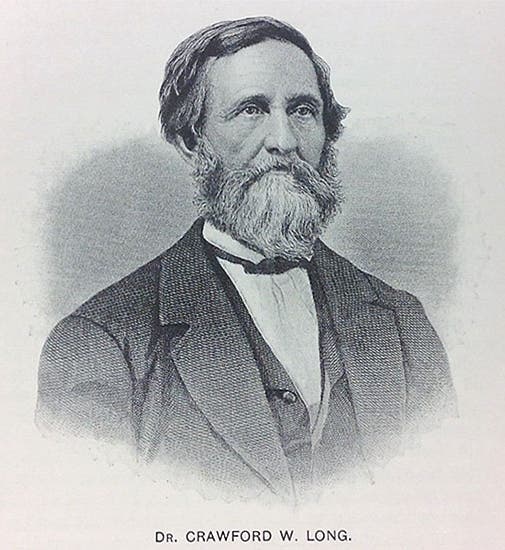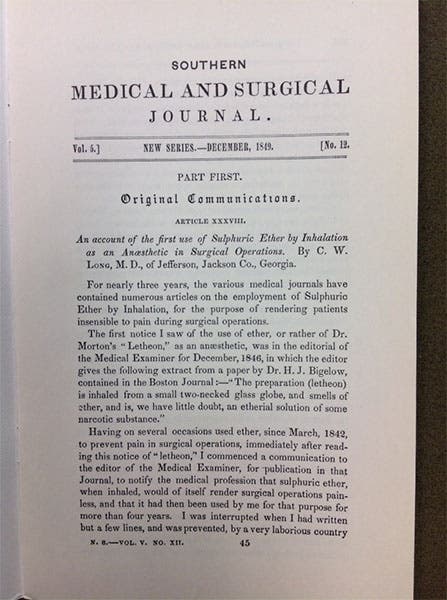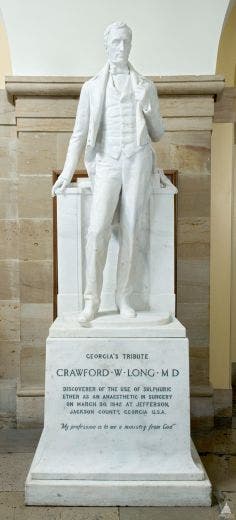Scientist of the Day - Crawford Long
Crawford Long, an American physician, was born on November 1, 1815 in Danielsville, Georgia (first image). The studious son of a wealthy merchant, he enrolled in Franklin College - as the University of Georgia was then known - at the age of 14. Despite his young age, Long graduated second in his class and chose to pursue a career in medicine. After a one-year introduction to surgery at Transylvania College in Lexington, Kentucky, he completed his training at the University of Pennsylvania.
Long briefly contemplated becoming a naval surgeon before returning to Georgia and setting up a medical practice in the town of Jefferson. Over time, he became a fixture in the community, and his office turned into a popular meeting place for Jefferson’s young men. During one gathering in December 1841, a crowd asked Long to prepare some nitrous oxide, a gas whose intoxicating effects were popular at parties during the early decades of the 19th century. As Long wrote later, “I informed them that I had no apparatus for preparing or preserving the gas, but that I had a medicine (sulphuric ether) which would produce equally exhilerating effects.” His guests were not disappointed, and soon Long was hosting regular “ether frolics” that attracted crowds from across the county.
At some point, Long observed that while inhaling ether, people did not seem to notice if they fell down or suffered other injuries. The apparent absence of pain while under the influence of the gas inspired him to conduct an experiment. On March 30, 1842, Long administered ether to one of his patients, James Venable, and proceeded to extract a tumor from his neck. Venable hardly stirred throughout the process and, as Long recalled, ‘assured me, after it was over, that he did not experience the slightest degree of pain from its performance.” This surgery marked the earliest known use of ether as a surgical anesthetic.
Building upon his initial success, Long conducted additional surgeries using ether during the spring and summer of 1842. While he discussed his accomplishments with local physicians, he did not share them more widely until 1849 (second image). Writing in the Southern Medical and Surgical Journal, he explained that this initial reticence stemmed from a lack of data confirming whether the gas was truly responsible for eliminating the sensation of pain. Furthermore, he feared that people would erroneously conflate the use of ether with mesmerism. Additional surgeries would be required to confirm the ether’s anesthetic properties to his satisfaction, but serious operations were relatively few and far between in rural Georgia. As a result, Long withheld from publishing his findings for over seven years.
What finally prompted Long to break his silence was a heated dispute over the invention of anesthesia. As discussed in a recent Scientist of the Day essay, dentist William Morton successfully demonstrated the anesthetic properties of sulphuric ether during an operation at Massachusetts General Hospital on October 16, 1846. Shortly afterward, Morton attempted to patent the use of surgical ether and declare himself the inventor of anesthesia. These claims did not go unanswered. Fellow dentist Horace Wells suggested that Morton’s ether experiments resembled his own investigations into the anesthetic properties of nitrous oxide. Charles Jackson, a chemist and physician who claimed to have explained ether’s potential medical applications to Morton, also wished to receive credit for his contributions.
For the next several years, the debates over which of these three men - Morton, Wells, and Jackson - should be considered the inventor of anesthesia played out in the scientific and popular press. By 1849, articles about the feud had reached Georgia, and Long felt compelled to call attention to his experiments, which preceded Morton’s Ether Day demonstration by more than four years. His account, accompanied by sworn testimonials from both patients and eyewitnesses, caused a stir in medical circles, and a swift backlash from Morton and Jackson. (Wells had passed away the previous year under tragic circumstances that deserve to be addressed in a future post.) Morton was particularly insistent that Long’s ether trials, conducted in relative isolation and without any major impact on surgical practice, were ultimately less significant than his own successful campaign to introduce anesthesia to the broader medical establishment.
Morton’s relentless self-promotion initially relegated Long to a peripheral role in the history of anesthesia. Over time, however, Long accumulated a growing number of supporters. Among his most prominent advocates were members of Georgia’s congressional delegation. These politicians were eager to promote the scientific achievements of a southerner, especially after the Civil War. In 1926, Long was chosen as one of two Georgians represented in the National Statuary Hall in the United States Capitol (third image).
Further evidence of Long’s rising scientific stature came in 1940. That year, the U.S. Postal Service selected him as one of five scientists featured on their “Famous Americans Series” of postage stamps (fourth image), along with John James Audubon, Luther Burbank, Walter Reed, and Jane Addams. He was the first anesthesiologist to appear on an American postage stamp, though not the last.
In addition to the tributes outlined above, Long is also the namesake of a museum dedicated to the history of medicine in Jefferson, Georgia, the town where he conducted his first ether experiments. After walking through recreations of an antebellum era doctor’s office, apothecary shop, and general store, visitors can examine artifacts and documents previously owned by the physician who quietly confirmed that surgery could be painless.
Benjamin Gross, Vice President for Research and Scholarship, Linda Hall Library. Comments or corrections are welcome; please direct to grossb@lindahall.org. Special thanks to Dawn McInnis at the Clendening History of Medicine Library at the University of Kansas Medical Center for providing images for this post.









